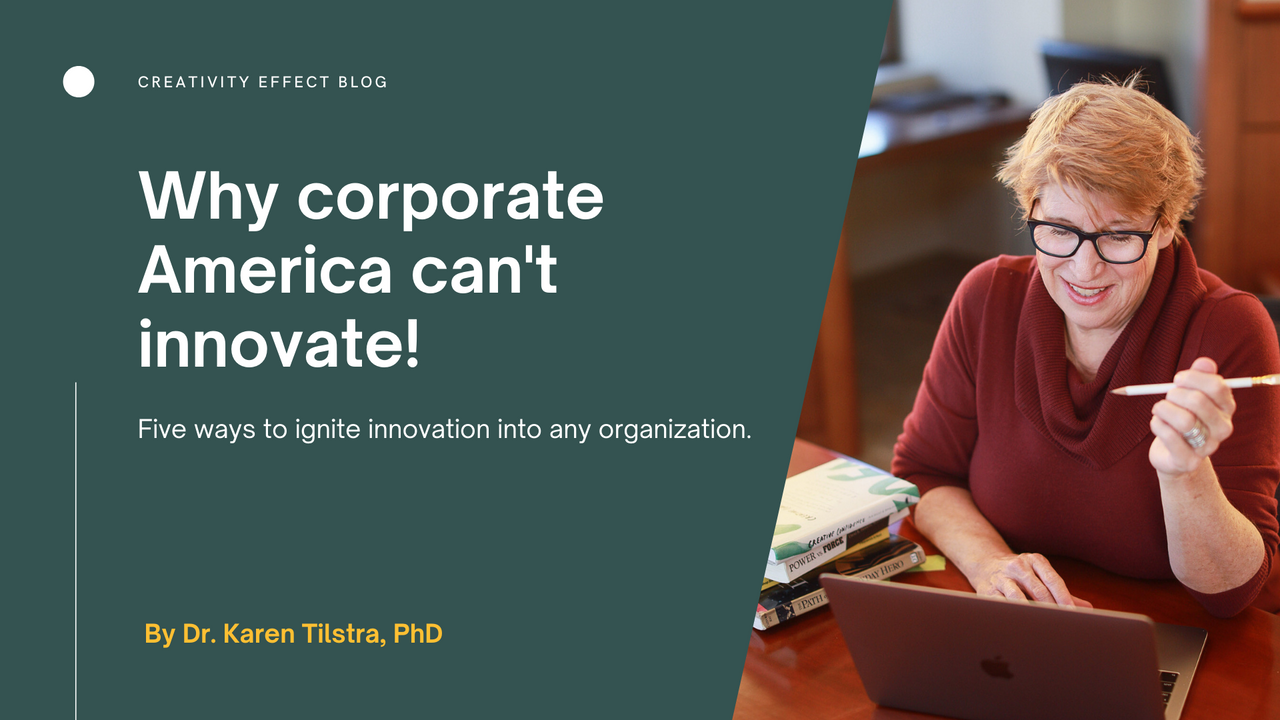Why Corporate America Can't Innovate and How to Fix It!
Jul 22, 2020
Five Ways to Ignite Innovation into Any Organization
If we are all creative with leadership potential, why does innovation remain so elusive in corporate America?
Perhaps the biggest reason why is because the hierarchy doesn’t allow leadership to emerge where and when it’s needed. Under the traditional system, leaders are picked and placed at the head of the conference table. Then the ingrained hierarchy calls for all decisions, big and small, to be run through these chosen leaders. Which on one hand is beneficial, but the reality is it also creates massive barriers, blocks flow, and makes the front-workers and end-users invisible and voiceless.
What does this have to do with innovation?
Well, to be innovative two key things need to happen: 1) People need to think creatively; 2) Everyone needs to be empowered to lead. Unfortunately, there is a deep-seated belief that leadership can only come from a single source or chaos will ensue. And that by letting people freely act on their creative ideas, production and efficiency will suffer.
So how do we move beyond this current pattern of stifling innovation and killing creative ideas before they have a chance to grow? Well, before we can move forward, it’s important to look back and see how we got here.
Let’s pause for a quick history lesson.
Around the turn of the 20th century, just as the second industrial revolution hit, the United States didn’t have an organized workforce to handle the exploding industries. To solve the problem, “management” was created and how Americans worked was completely altered. People went from being self-employed and living in rural society to working in huge factories and living in an urban society.
For these factories to be successful, workers needed to be trained to quickly and accurately follow instructions. No longer were Americans working for themselves, exercising their creativity. Now they were begin managed by a supervisor, a labeled leader determining the “right” way and the “wrong” way to accomplish a task, robbing employees of their creative voices and opportunities for leadership. In these work environments, high efficiency and following a specific set of work guidelines superseded the creative process and collaboration.
What Worked Then Is Irrelevant Now
How Americans work is again going through a major transition. As the world becomes more globally connected through the Internet and we’re able to instantly communicate with anyone, anywhere in the world, traditional leadership and management become obsolete. Efficiently and speed are no longer what matters most. Instead, the most innovative environments allow the best possible solutions to emerge from anywhere and anyone.
Are such environments messier and less efficient? Certainly! However, they’re also far more effective. Why? Because when you tap into the collective creative intelligence, you create relevant solutions to the problems the world is actually experiencing.
How to Fix Our Great Innovation Problem
For so long the American workforce has been programmed to follow where management leads and to value speed and efficiency above everything else. While this may have worked once upon a time, this continued approach is creating a profound lack of innovation in corporate America.
Thankfully this doesn’t have to be you and your organization. As a leader, there are simple mindsets and habits you can practice to ignite innovation:
- Pause and Assess. When a challenge arises, pause for a second to assess what’s actually going on.
- Identify Assumptions. Routinely stop and ask yourself, “What assumptions am I making and how are they influencing me?”
- Embrace Other Opinions. There are always two (or three) sides to a story, opening listen to the other opinions.
- Seek Alternative Perspectives. Actively search for and talk to people who can offer another perspective.
- One Iteration at a Time. Don’t think your first ideas have to be the one that sticks. Innovation is an ever-evolving process always evolving. Each iteration offers new insight, getting you closer to a relevant and sustainable solution.
And in every case, try NOT to take yourself too seriously - look for the fun and adventure and how you might widen the knowledge circle. You might be surprised how it all turns out!
Keep inspiring creativity!
- Karen
